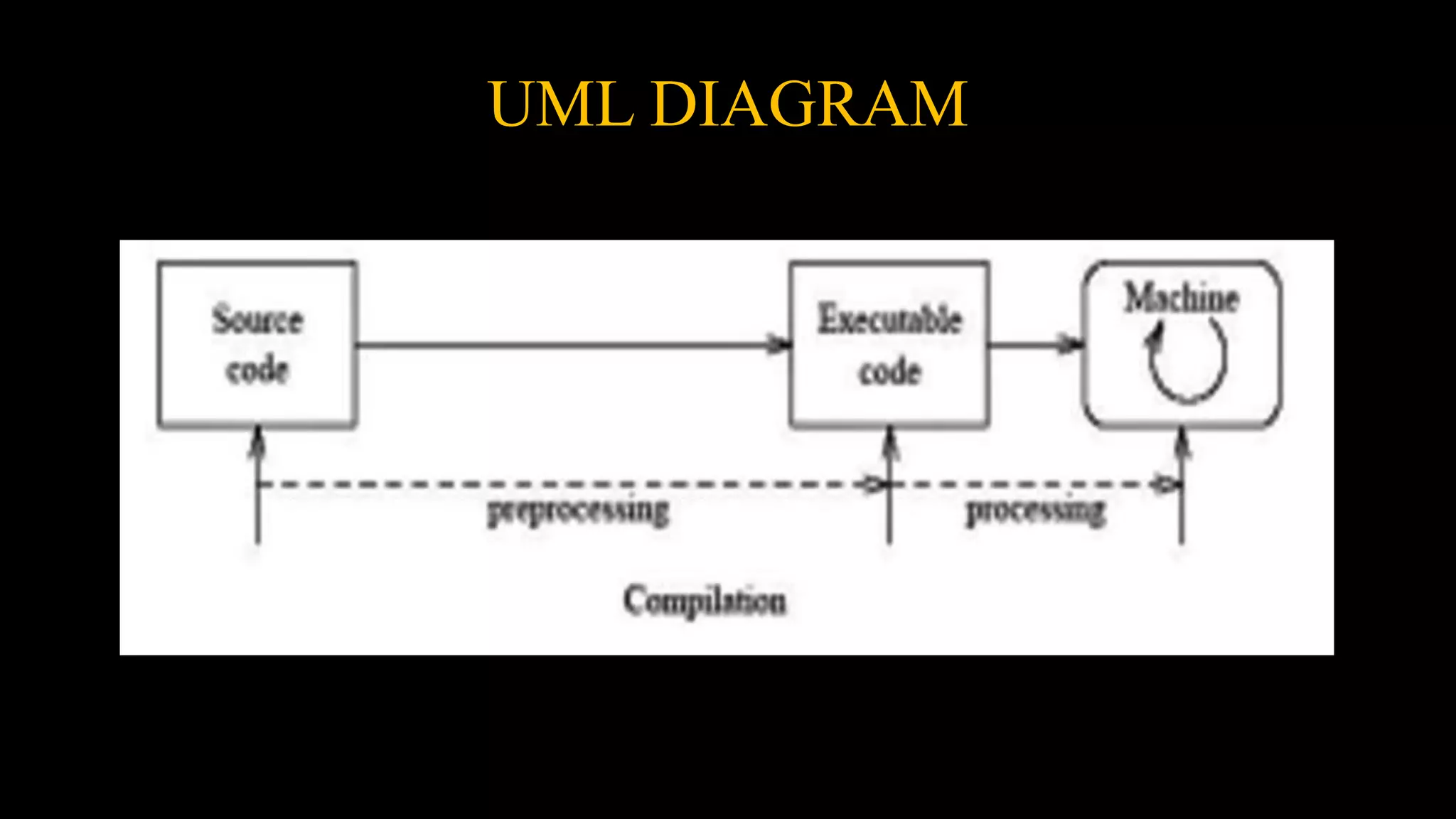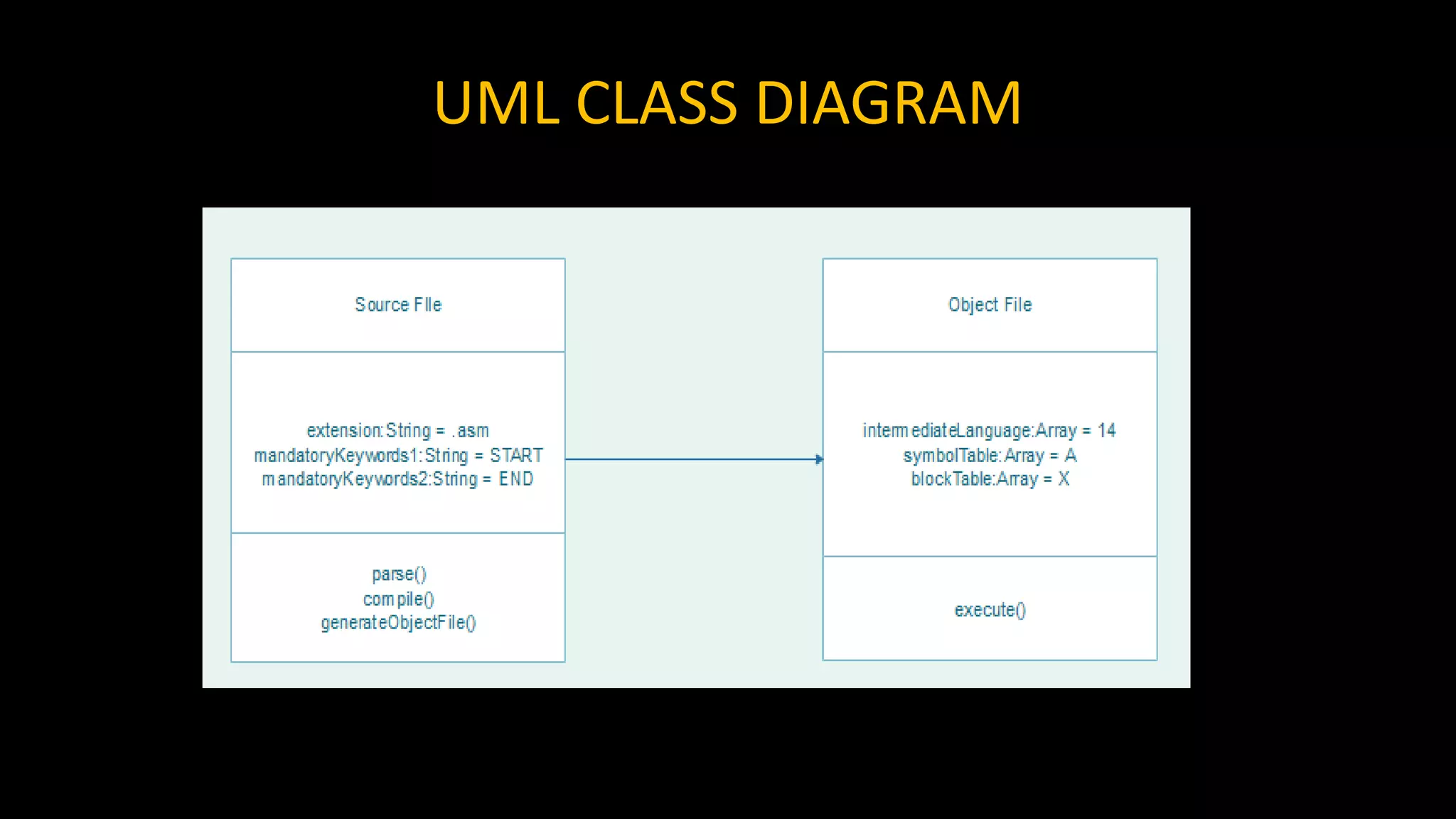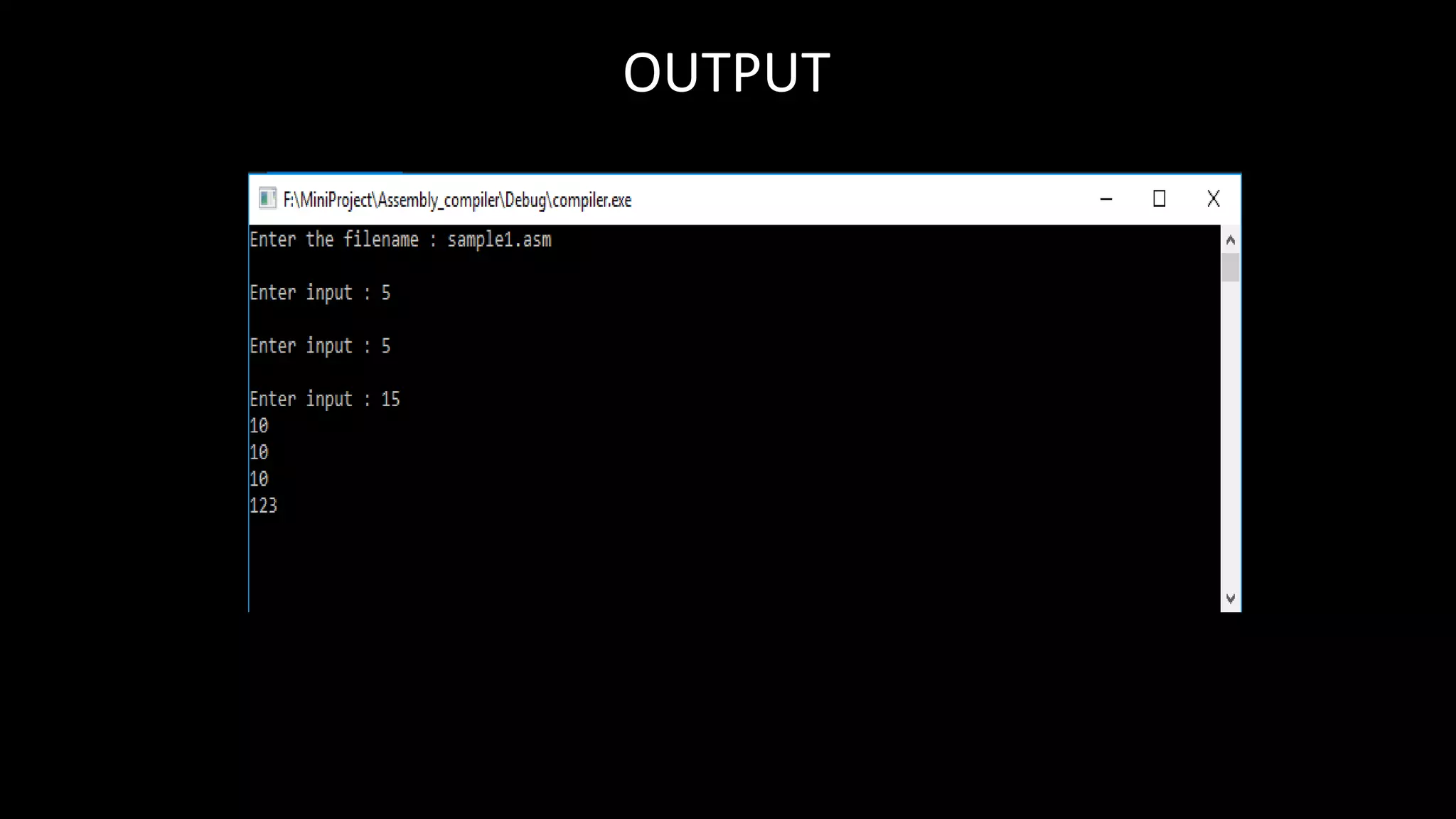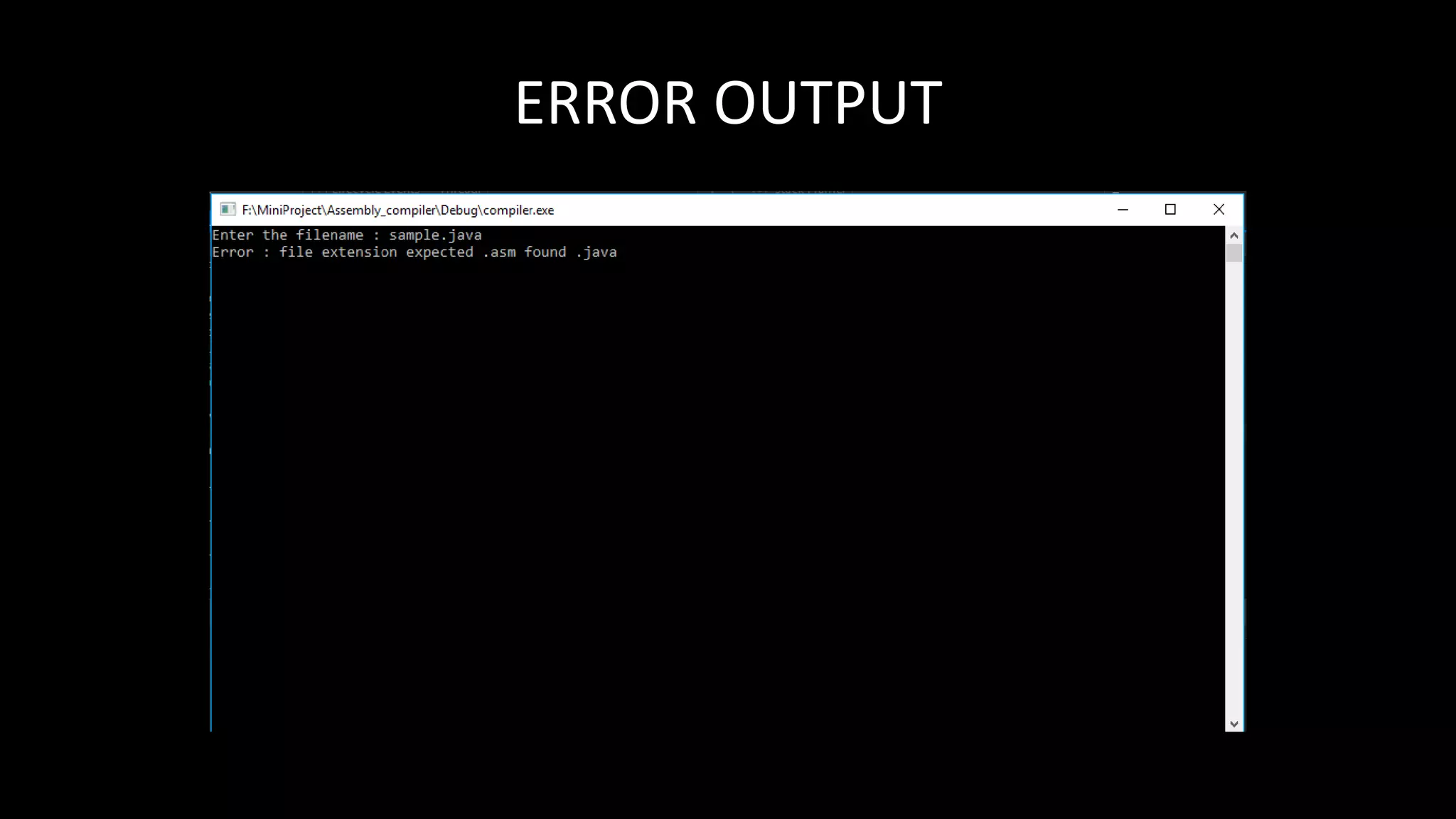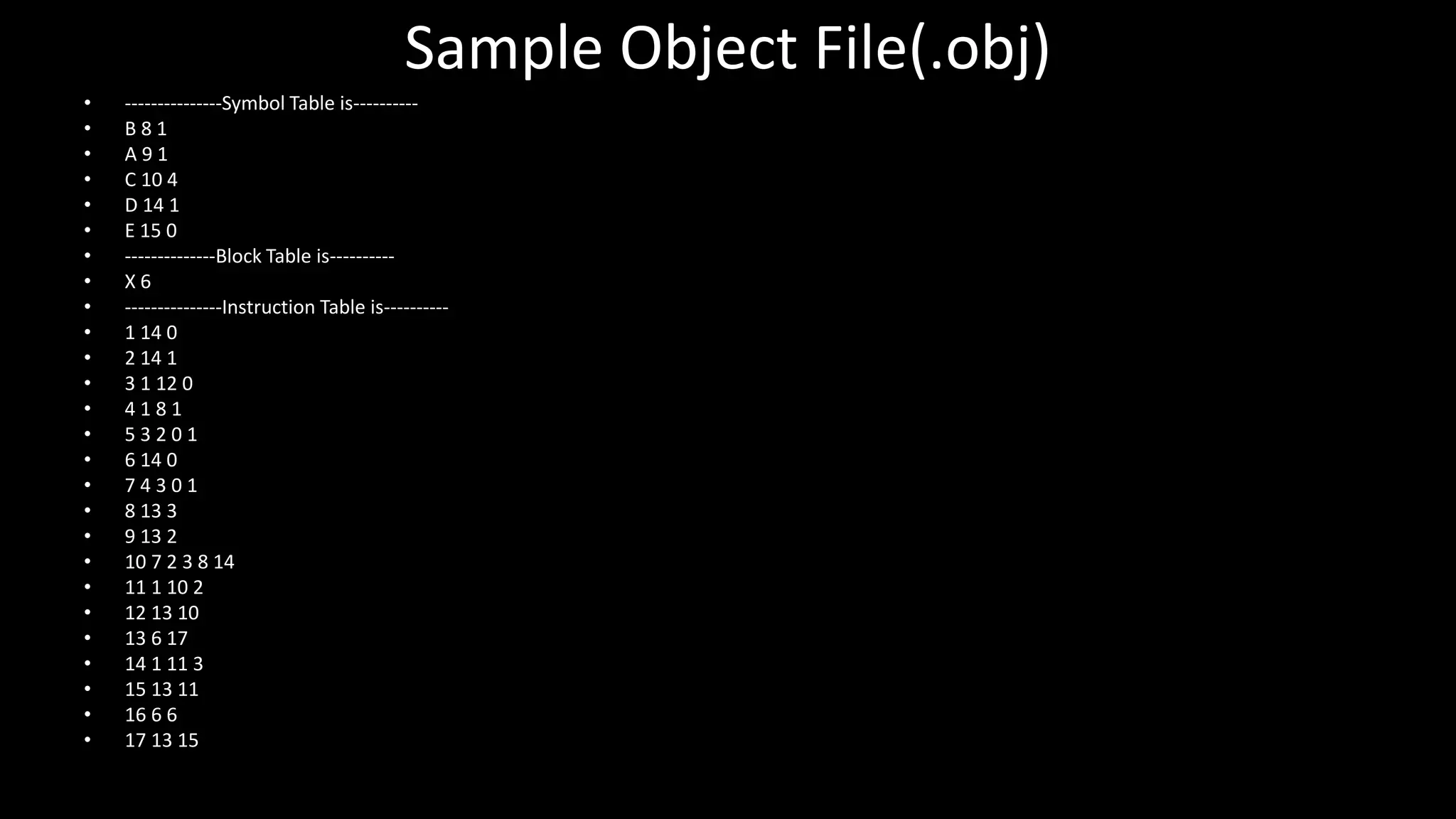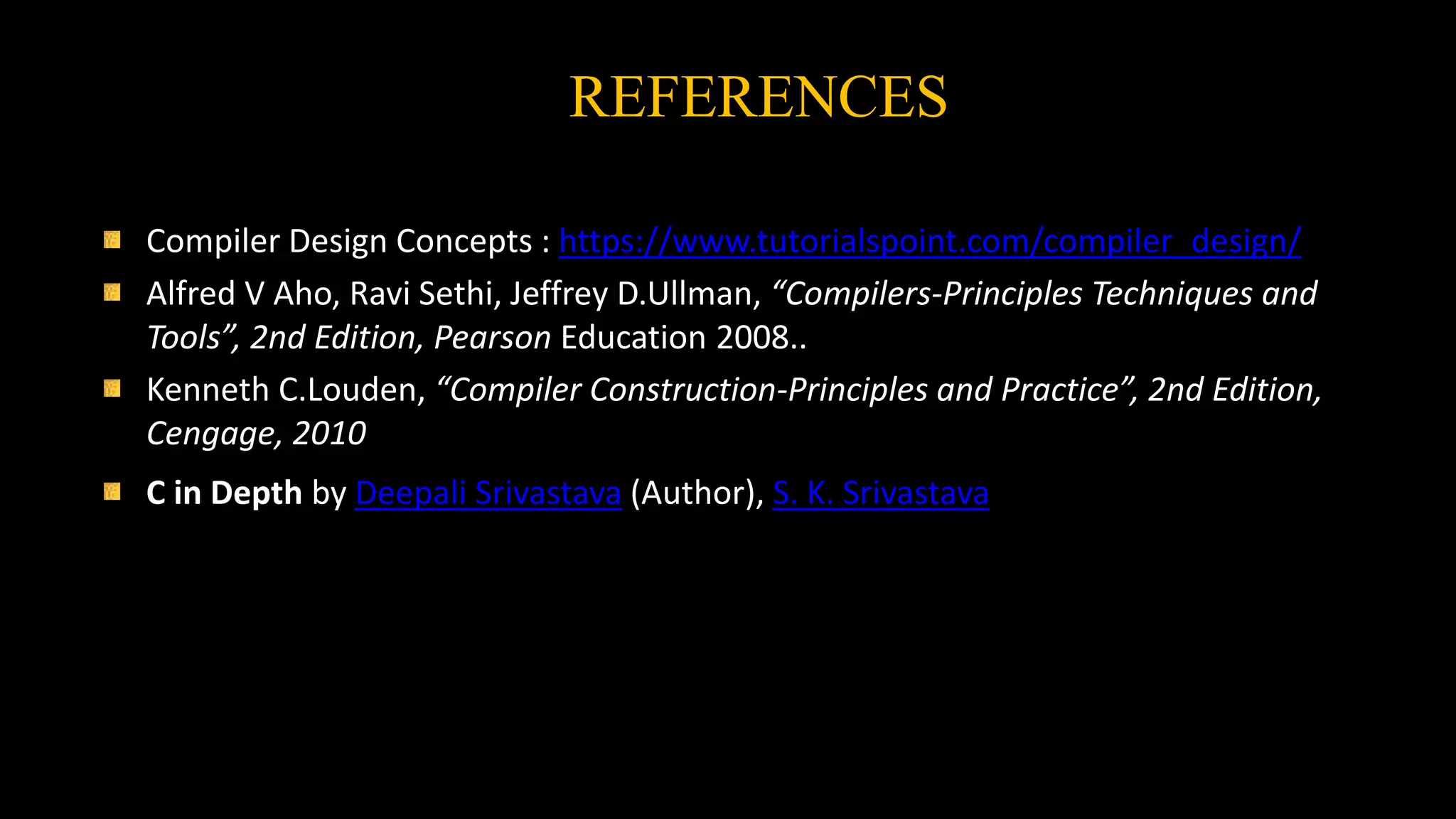The document outlines the design and implementation of a compiler that converts assembly language instructions into machine code. It details system requirements, modules for compilation and execution, and various instructions and their operations, including arithmetic and logic procedures. Additionally, it includes examples of assembly code, the resulting intermediate language, and references for further reading on compiler design concepts.
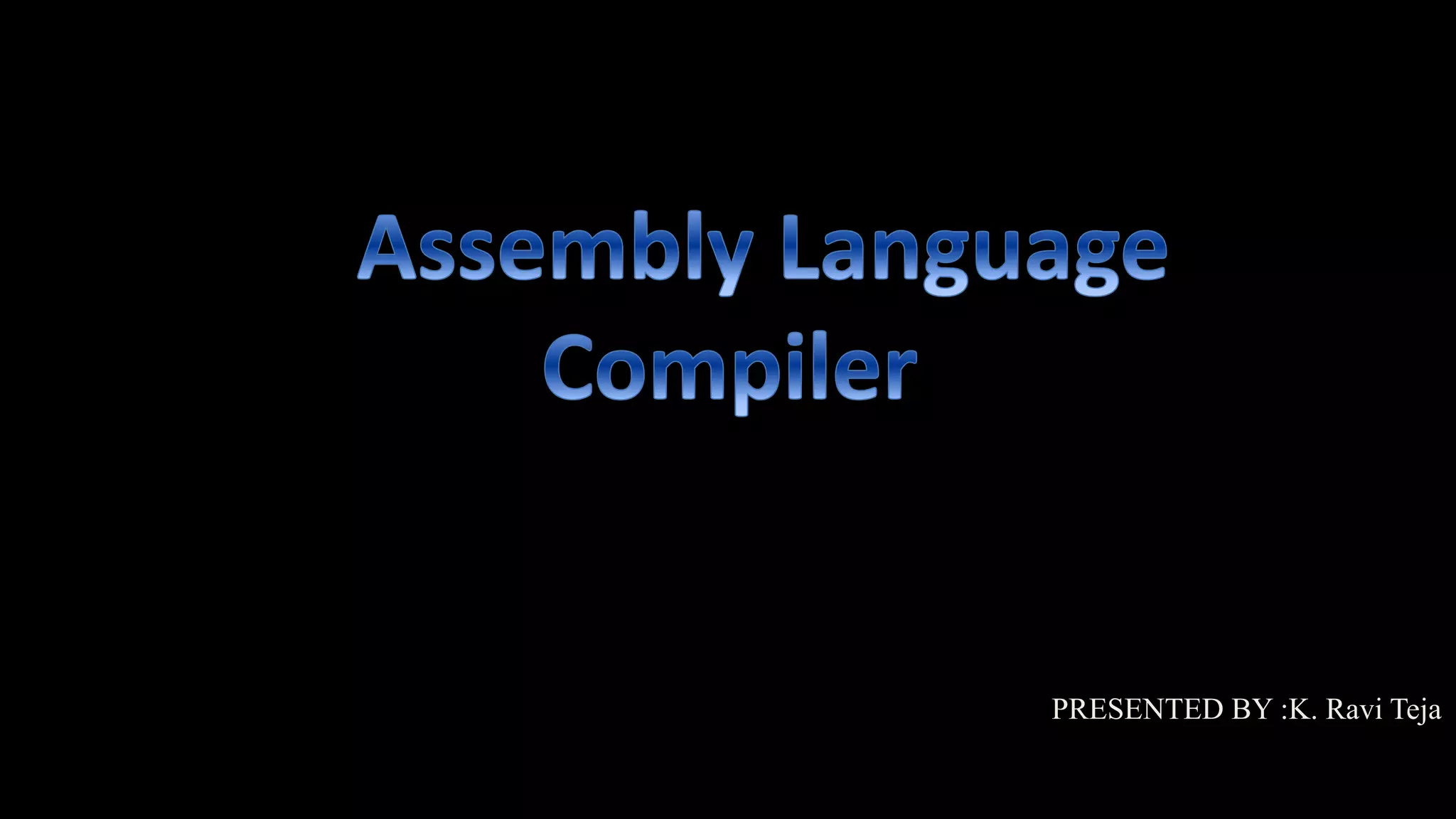
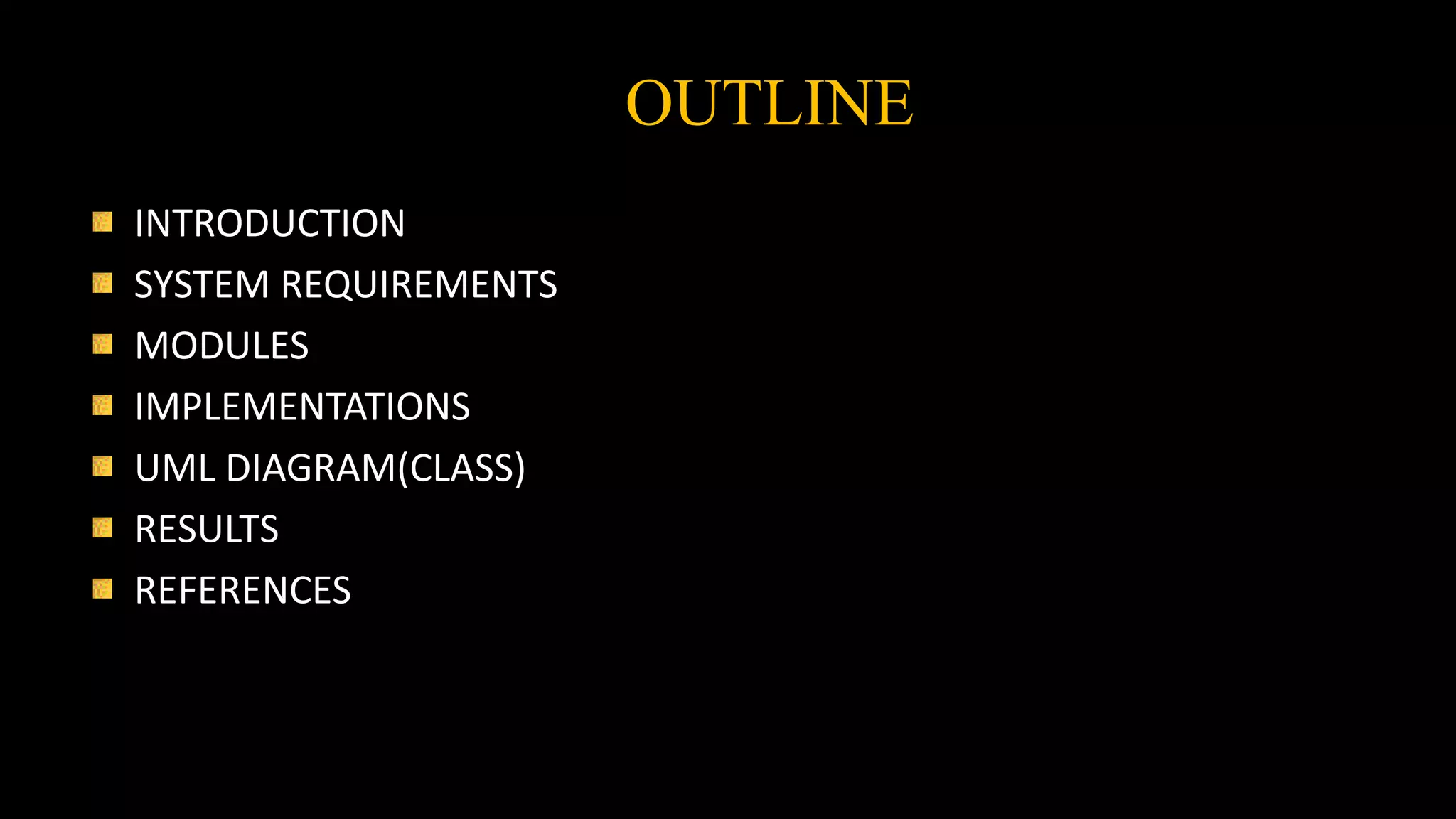
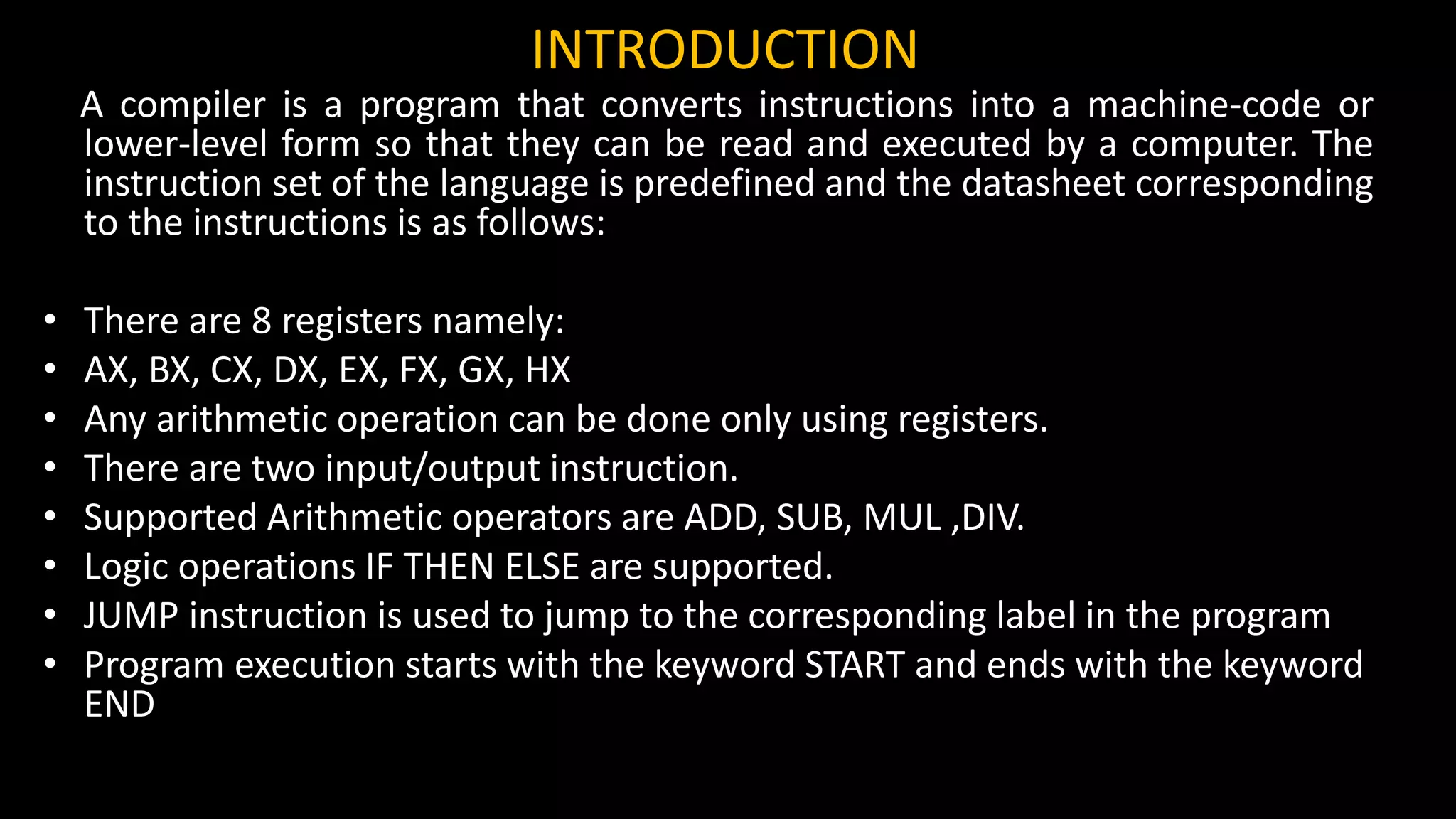
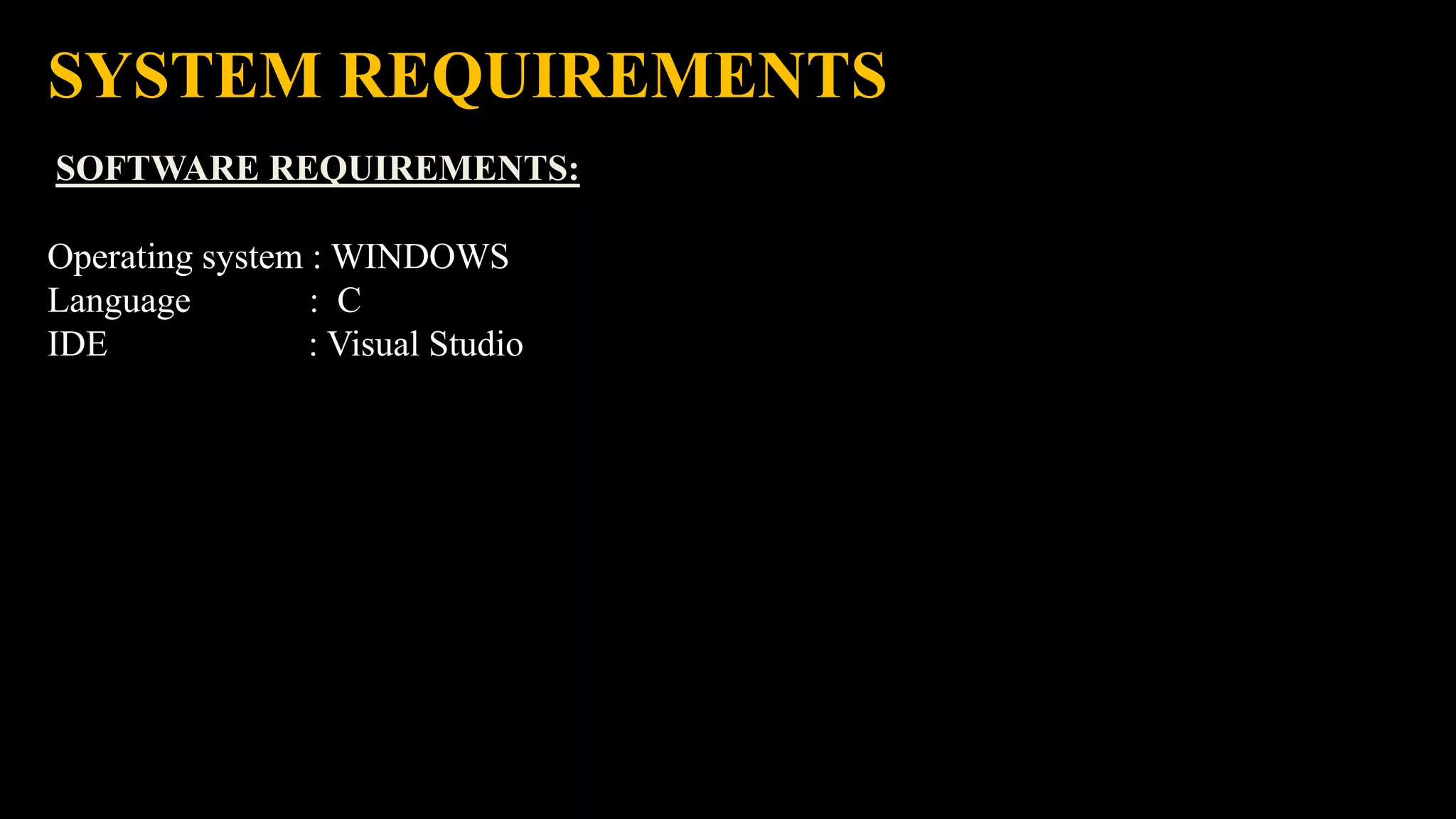
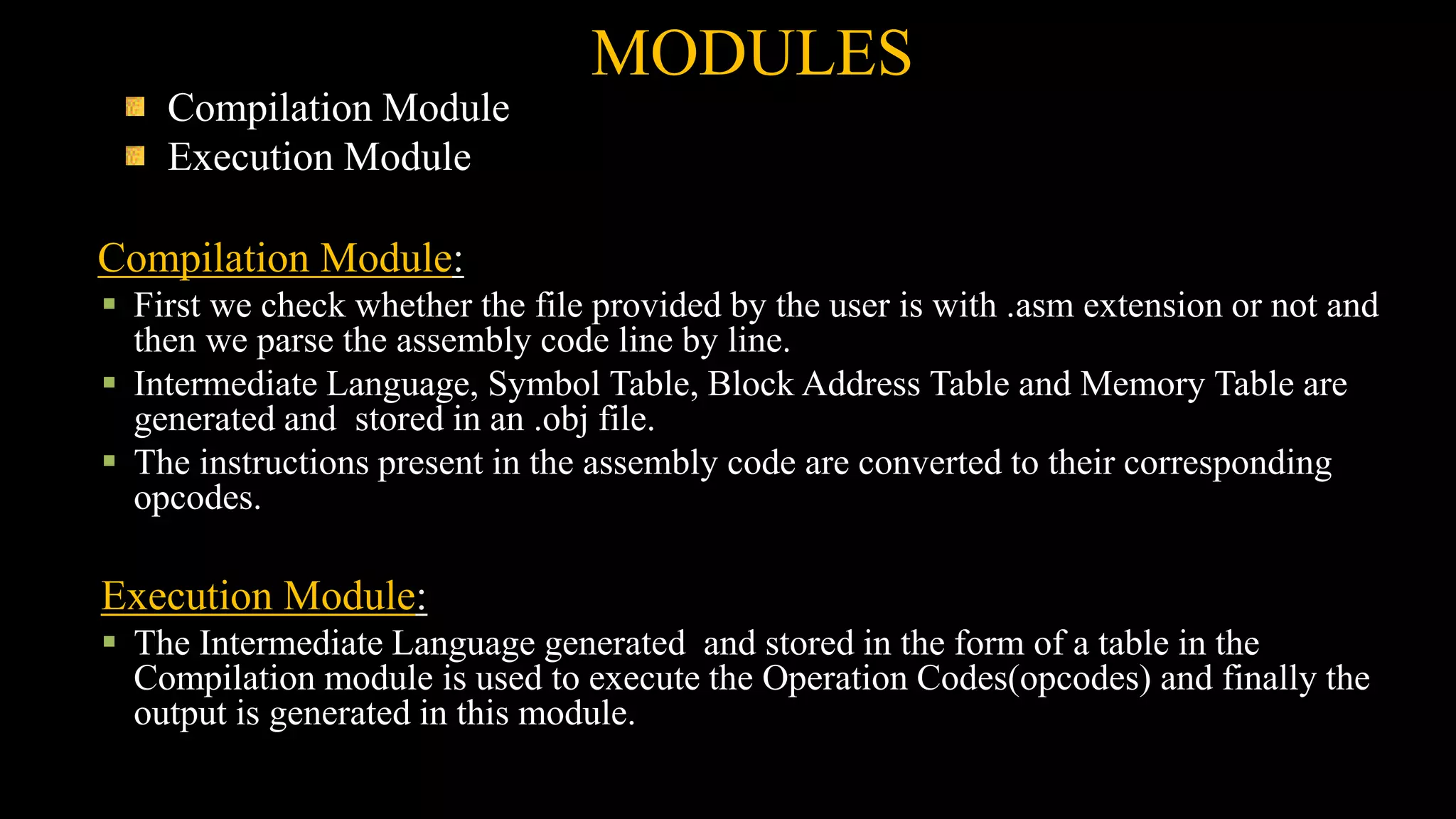
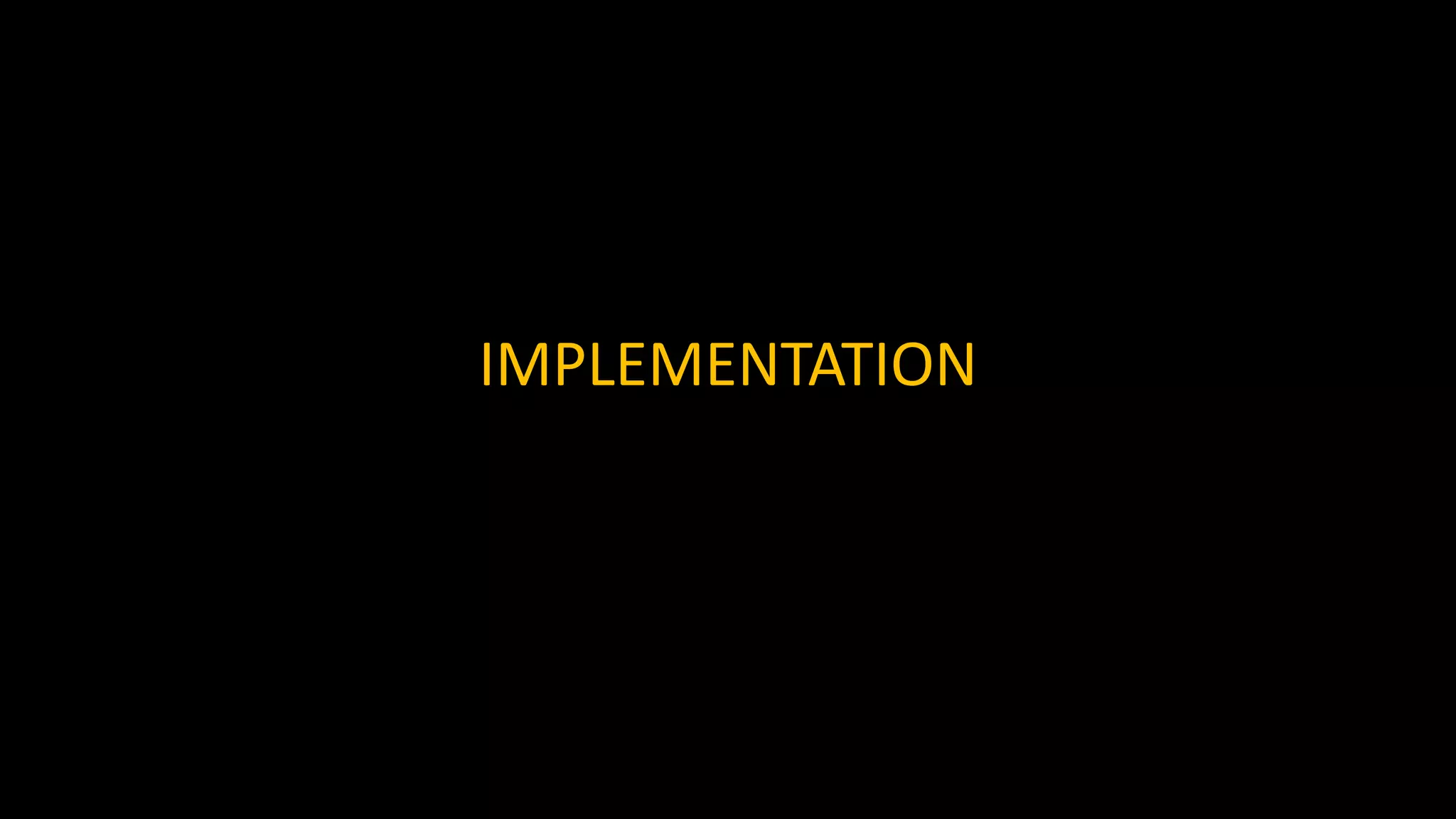
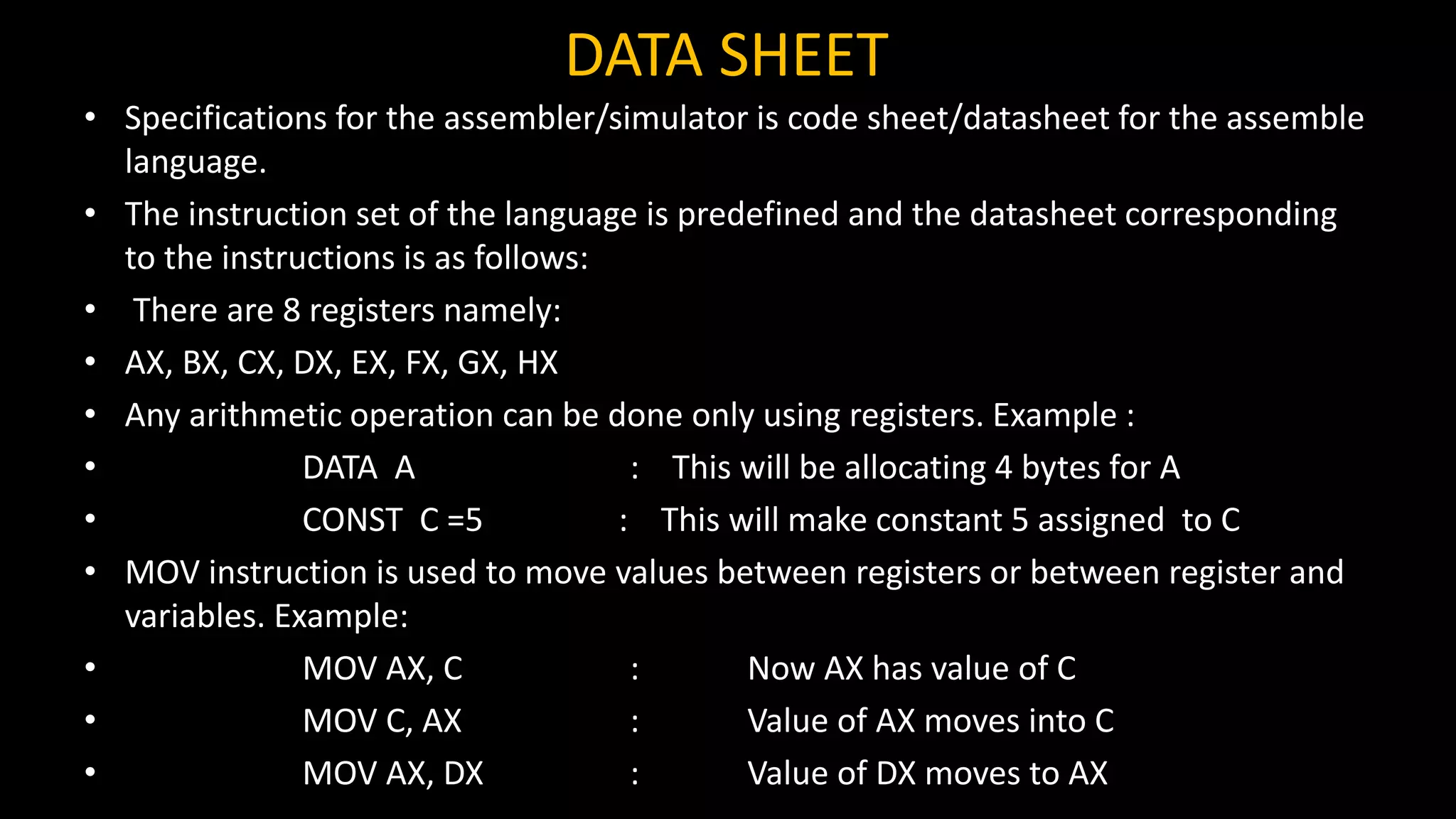
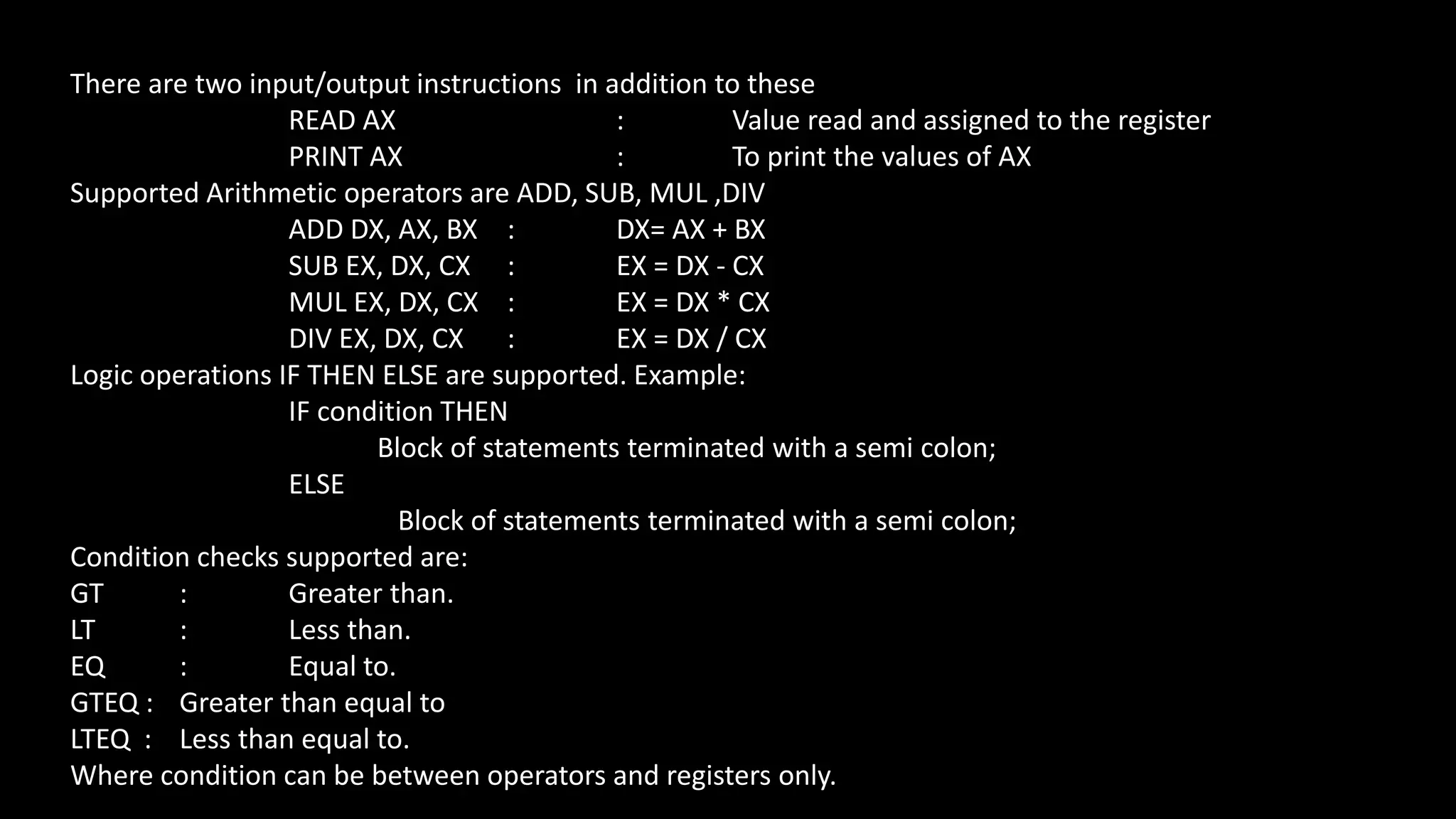
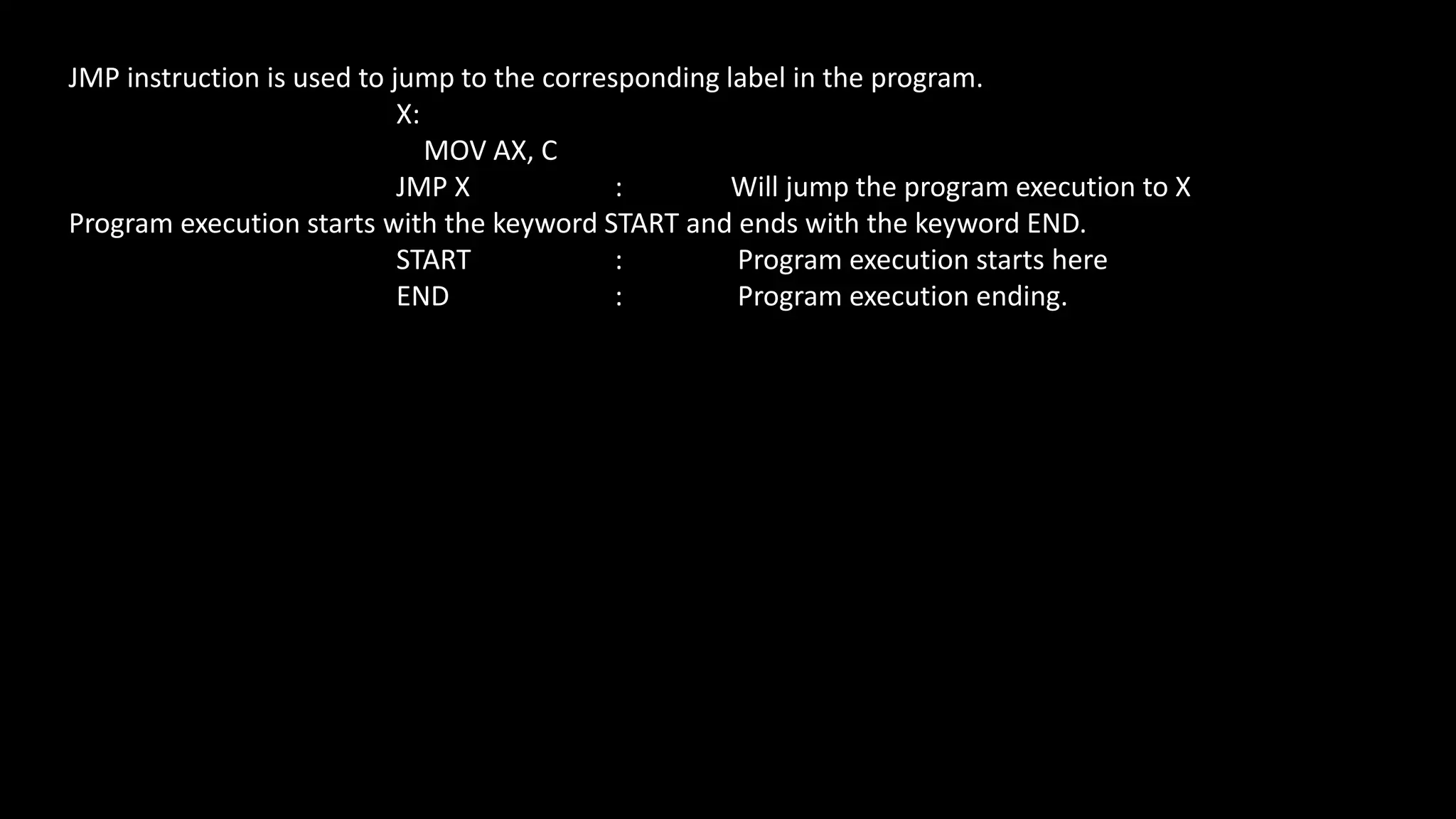
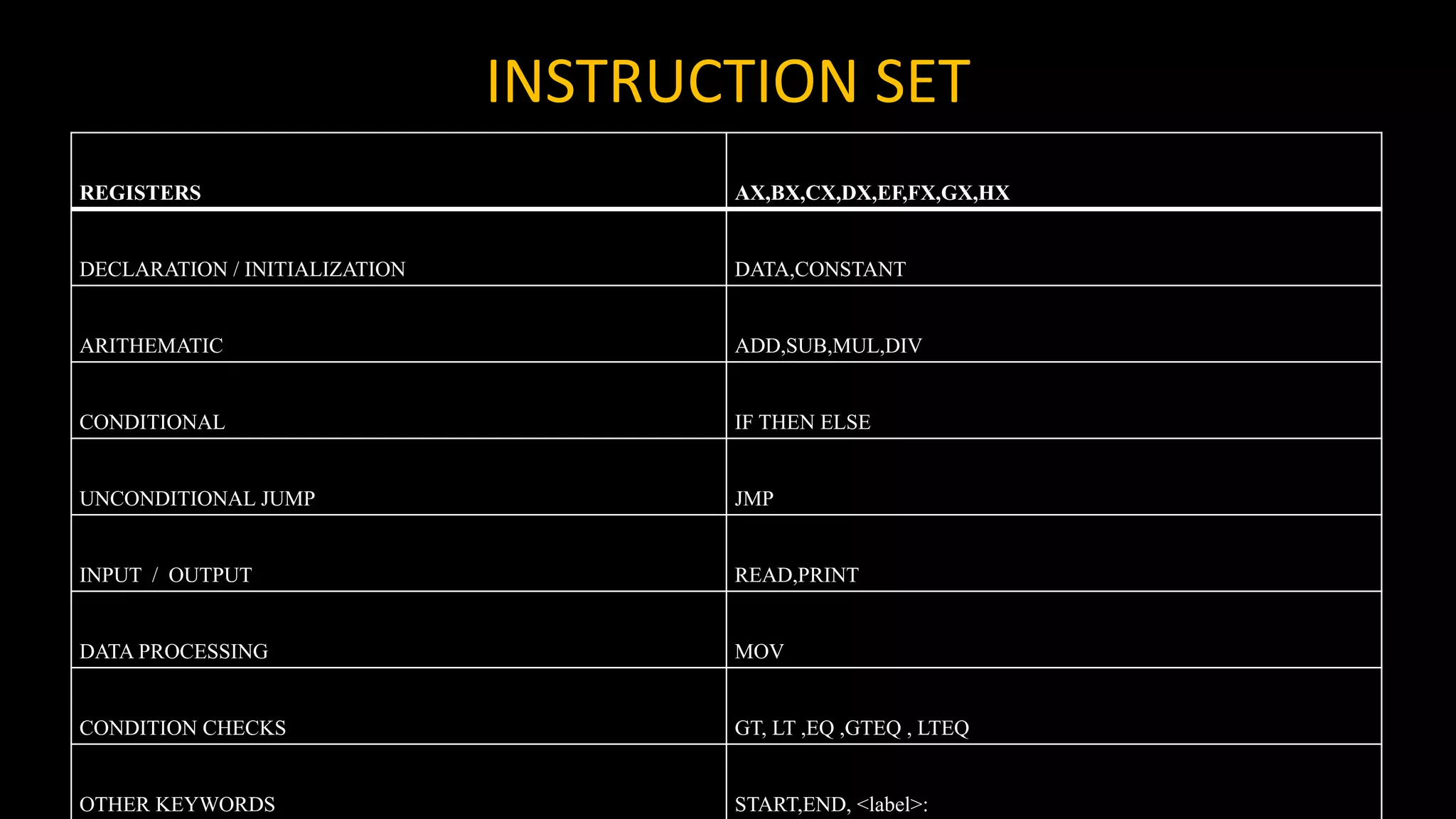
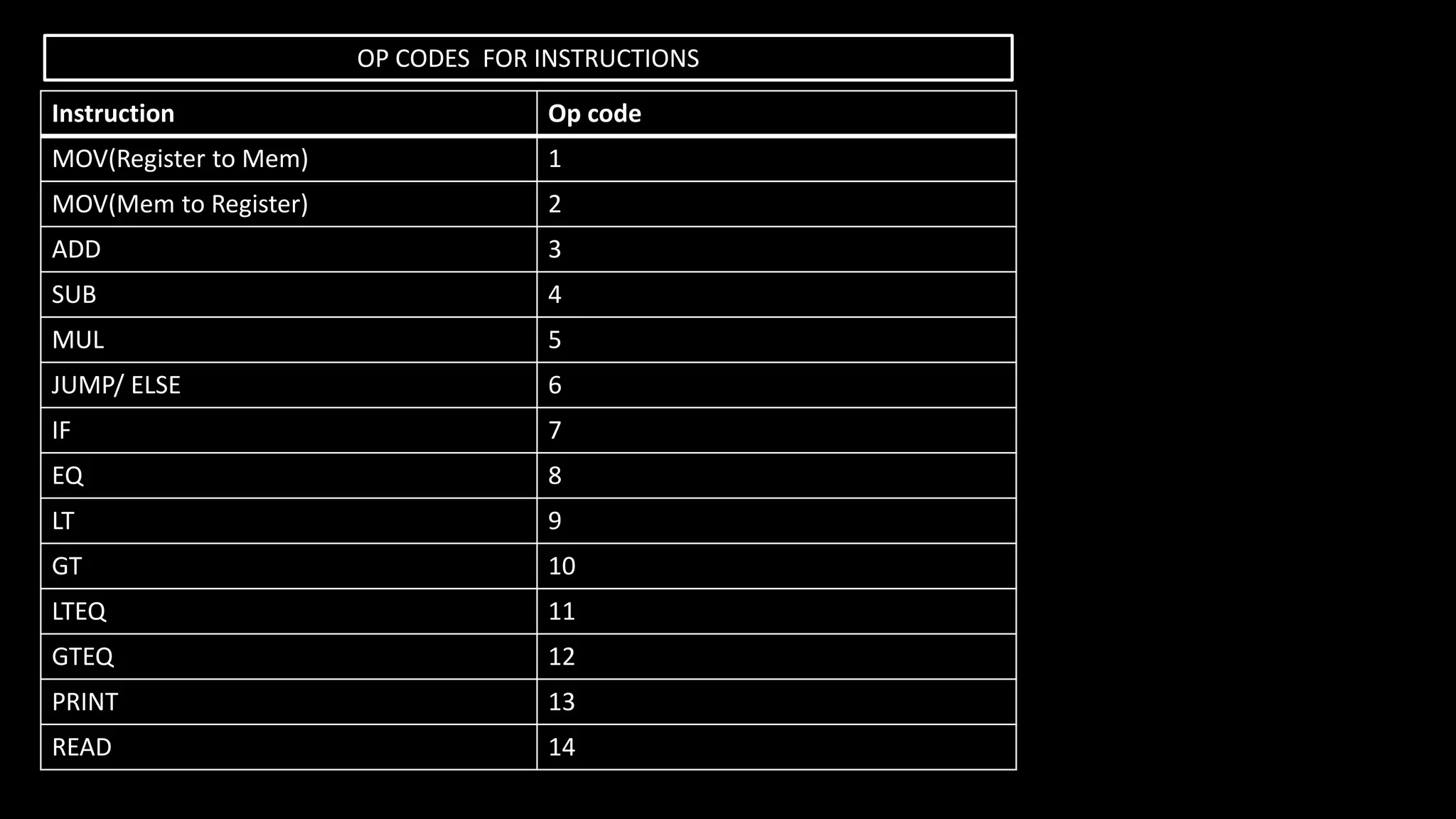
![Sample Assembly Code
• DATA B
• DATA A
• DATA C[4]
• DATA D
• CONST E = 8
• START:
• READ AX
• READ BX
• MOV A, AX
• MOV B, BX
• ADD CX, AX, BX
• MOV DX, E
• X:
• IF CX EQ DX THEN
• MOV C[0], CX
• MOV D, CX
• ELSE
• MOV C[1], CX
• ENDIF
• JUMP X
• END](https://image.slidesharecdn.com/compiler-170728124232/75/Assembly-Language-Compiler-Implementation-12-2048.jpg)
![DATA A
DATA C[4]
DATA D
CONST E = 0
START:
READ AX
READ BX
MOV A, AX
MOV B, BX
ADD CX, AX, BX
MOV DX, E
X:
IF CX EQ DX THEN
MOV C[0], CX
MOV D, CX
ELSE
MOV C[1], CX
ENDIF
JUMP X
END
DATA B](https://image.slidesharecdn.com/compiler-170728124232/75/Assembly-Language-Compiler-Implementation-13-2048.jpg)
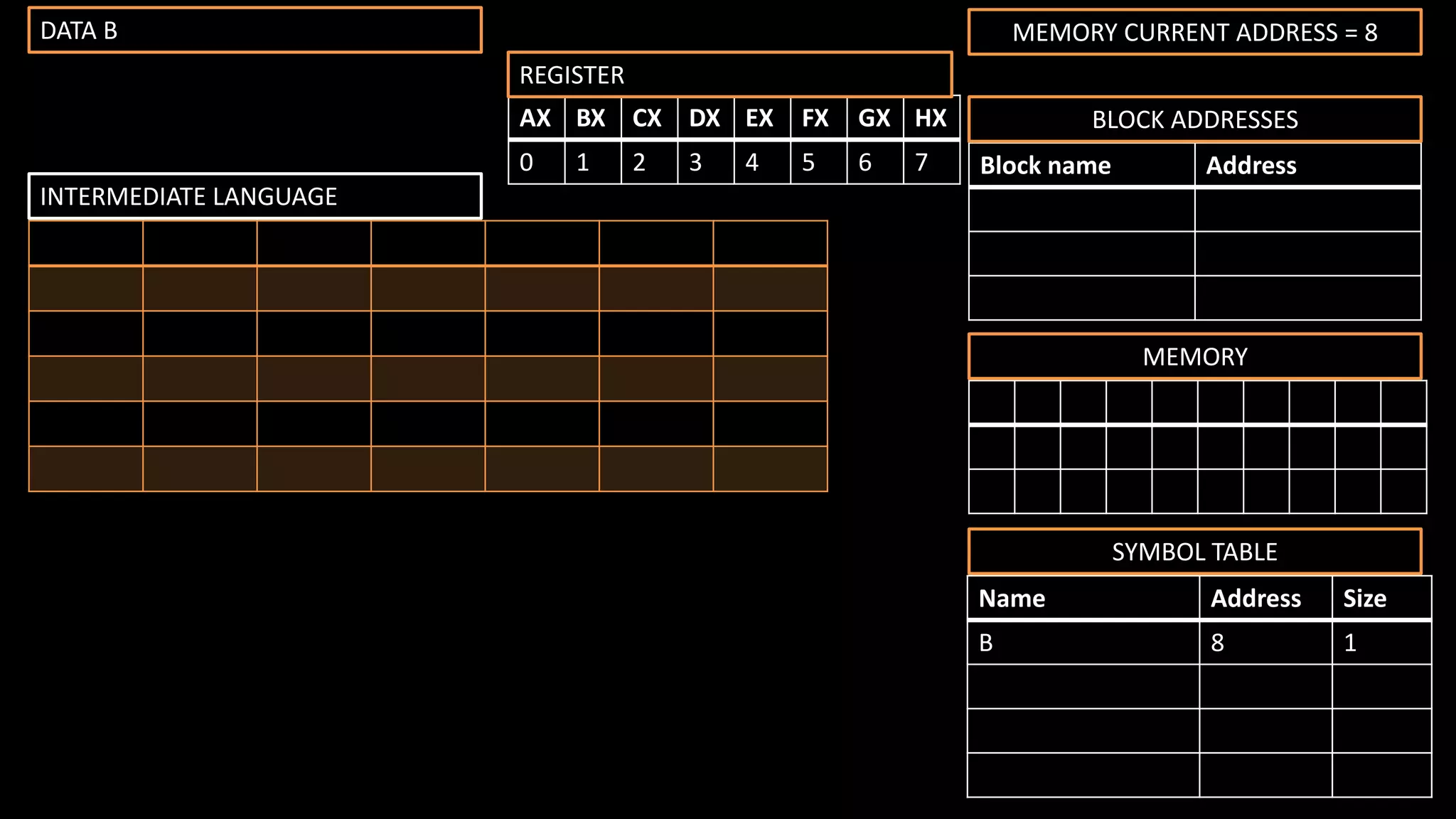
![DATA B
DATA C[4]
DATA D
CONST E = 0
START:
READ AX
READ BX
MOV A, AX
MOV B, BX
ADD CX, AX, BX
MOV DX, E
X:
IF CX EQ DX THEN
MOV C[0], CX
MOV D, CX
ELSE
MOV C[1], CX
ENDIF
JUMP X
END
DATA A](https://image.slidesharecdn.com/compiler-170728124232/75/Assembly-Language-Compiler-Implementation-15-2048.jpg)
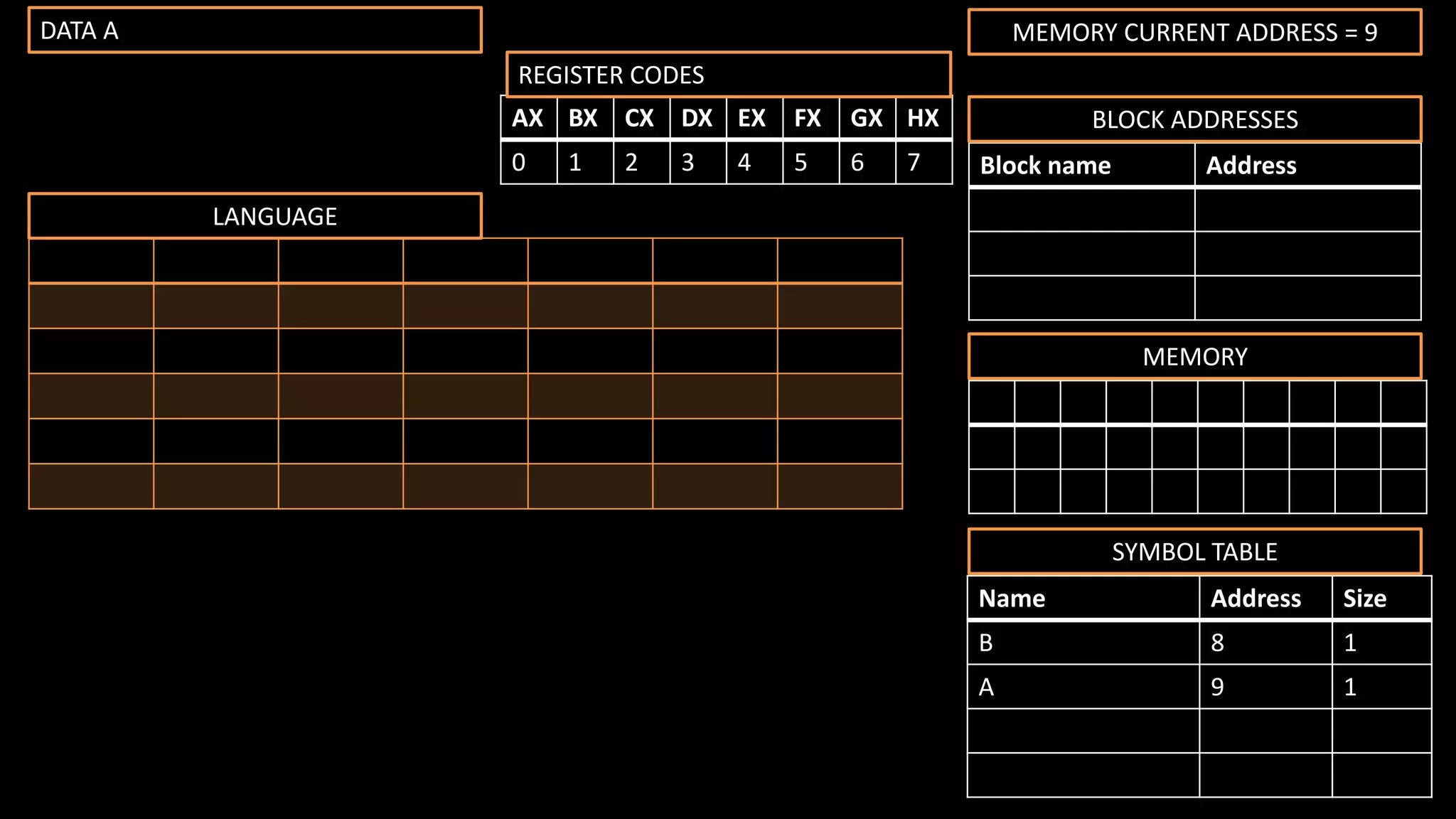
![DATA B
DATA A
DATA D
CONST E = 0
START:
READ AX
READ BX
MOV A, AX
MOV B, BX
ADD CX, AX, BX
MOV DX, E
X:
IF CX EQ DX THEN
MOV C[0], CX
MOV D, CX
ELSE
MOV C[1], CX
ENDIF
JUMP X
END
DATA C[4]](https://image.slidesharecdn.com/compiler-170728124232/75/Assembly-Language-Compiler-Implementation-17-2048.jpg)
![MEMORY
Name Address Size
B 8 1
A 9 1
C 10 4
SYMBOL TABLE
Block name Address
BLOCK ADDRESSES
DATA C[4] MEMORY CURRENT ADDRESS = 10
INTERMEDIATE LANGUAGE
AX BX CX DX EX FX GX HX
0 1 2 3 4 5 6 7
REGISTER CODES](https://image.slidesharecdn.com/compiler-170728124232/75/Assembly-Language-Compiler-Implementation-18-2048.jpg)
![DATA B
DATA A
DATA C[4]
CONST E = 0
START:
READ AX
READ BX
MOV A, AX
MOV B, BX
ADD CX, AX, BX
MOV DX, E
X:
IF CX EQ DX THEN
MOV C[0], CX
MOV D, CX
ELSE
MOV C[1], CX
ENDIF
JUMP X
END
DATA D](https://image.slidesharecdn.com/compiler-170728124232/75/Assembly-Language-Compiler-Implementation-19-2048.jpg)
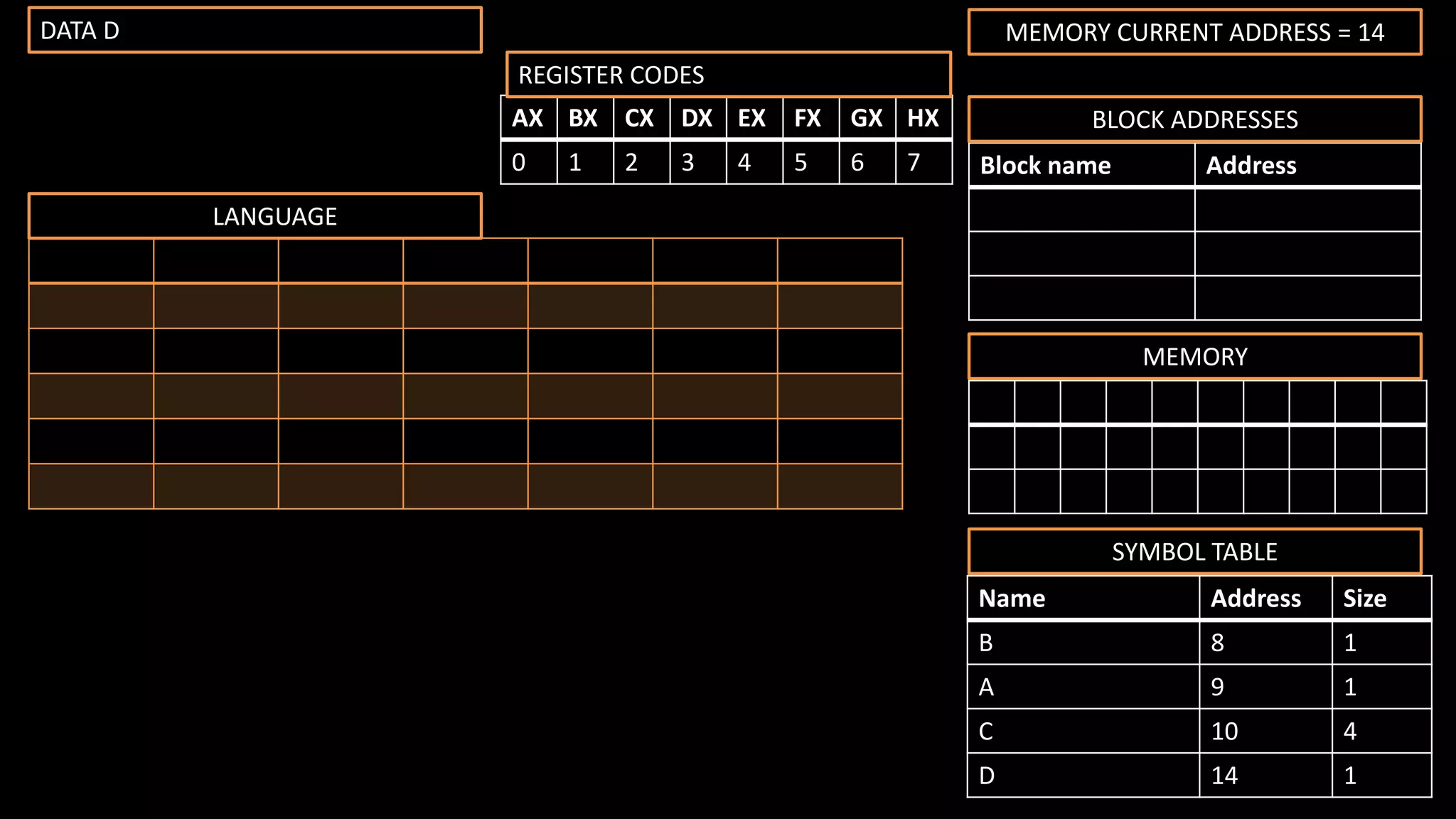
![DATA B
DATA A
DATA C[4]
DATA D
START:
READ AX
READ BX
MOV A, AX
MOV B, BX
ADD CX, AX, BX
MOV DX, E
X:
IF CX EQ DX THEN
MOV C[0], CX
MOV D, CX
ELSE
MOV C[1], CX
ENDIF
JUMP X
END
CONST E=0](https://image.slidesharecdn.com/compiler-170728124232/75/Assembly-Language-Compiler-Implementation-21-2048.jpg)

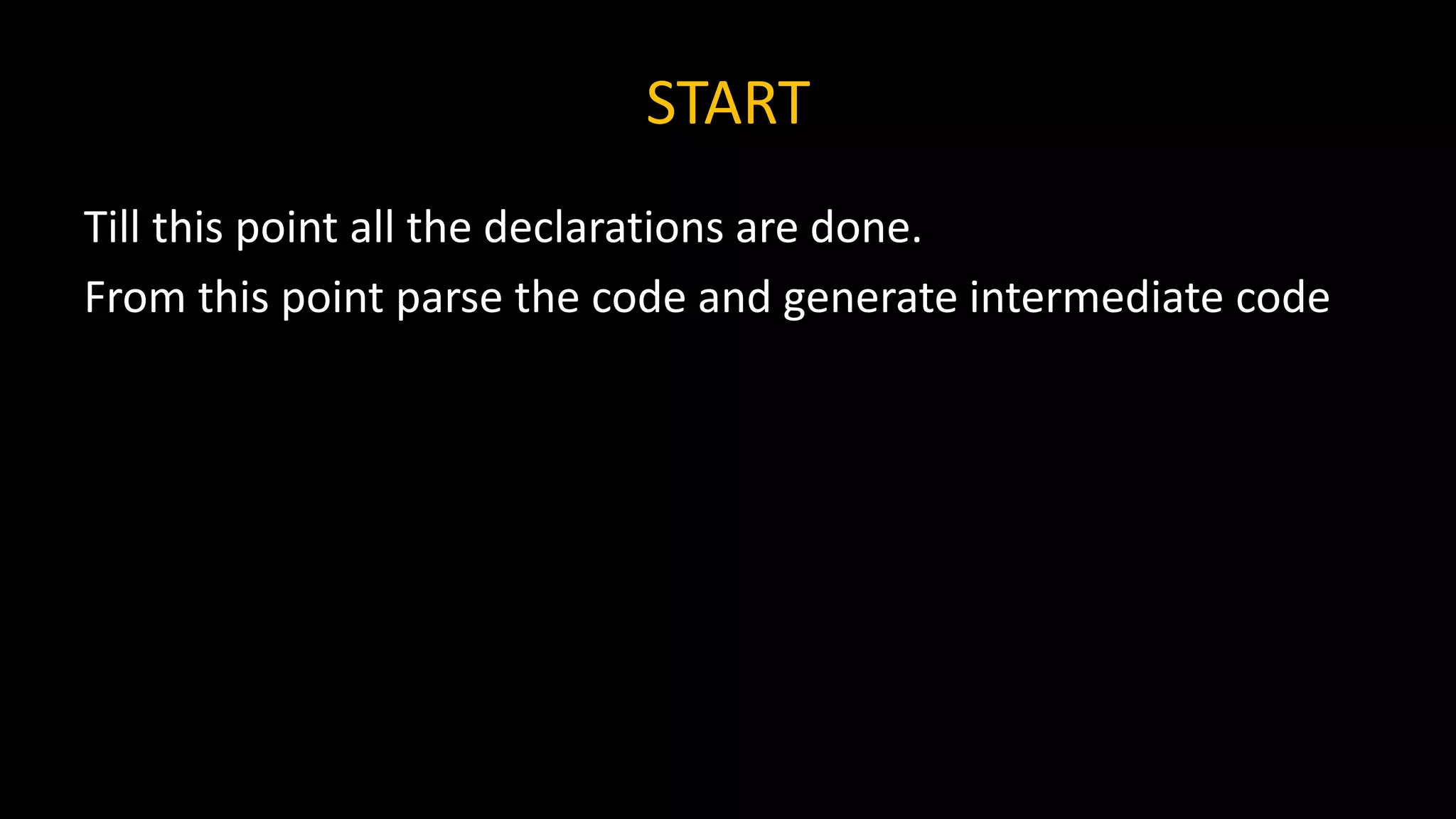
![DATA B
DATA A
DATA C[4]
DATA D
CONST E = 0
START:
READ BX
MOV A, AX
MOV B, BX
ADD CX, AX, BX
MOV DX, E
X:
IF CX EQ DX THEN
MOV C[0], CX
MOV D, CX
ELSE
MOV C[1], CX
ENDIF
JUMP X
END
READ AX](https://image.slidesharecdn.com/compiler-170728124232/75/Assembly-Language-Compiler-Implementation-24-2048.jpg)
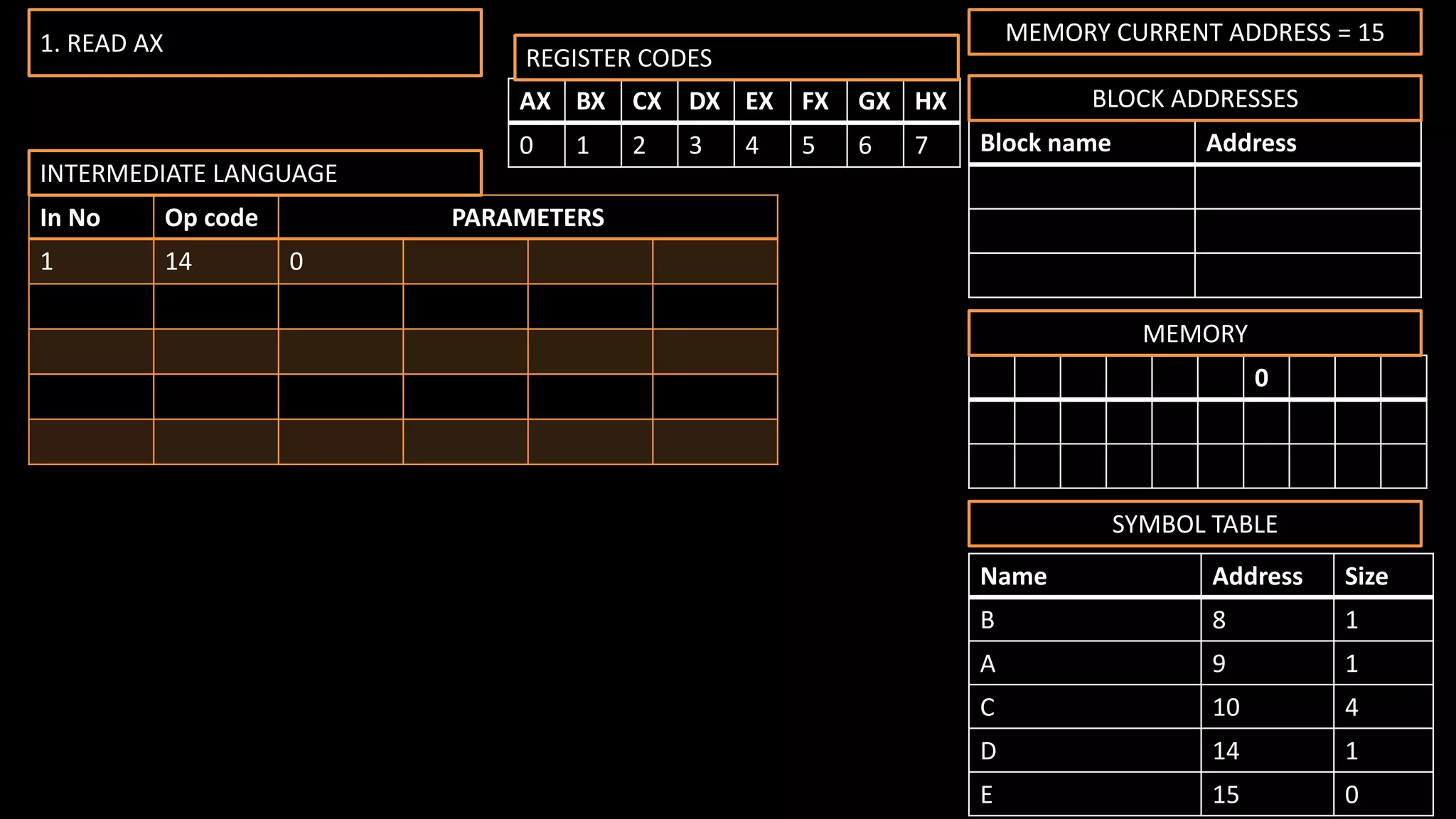
![DATA B
DATA A
DATA C[4]
DATA D
CONST E = 0
START:
READ AX
READ BX
MOV A, AX
MOV B, BX
ADD CX, AX, BX
MOV DX, E
X:
MOV C[0], CX
MOV D, CX
ELSE
MOV C[1], CX
ENDIF
JUMP X
END
IF CX EQ DX THEN](https://image.slidesharecdn.com/compiler-170728124232/75/Assembly-Language-Compiler-Implementation-26-2048.jpg)
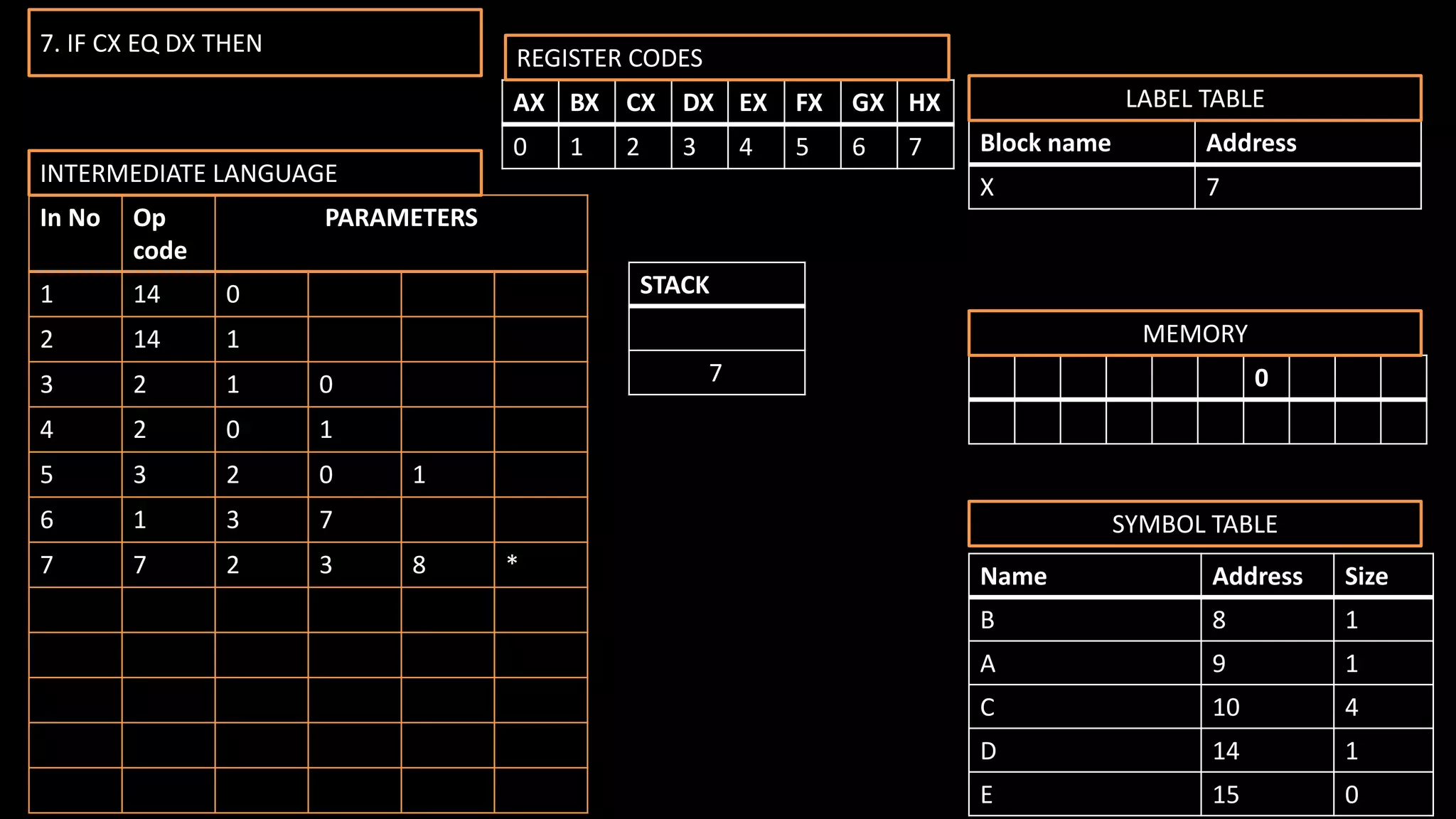
![DATA B
DATA A
DATA C[4]
DATA D
CONST E = 0
START:
READ AX
READ BX
MOV A, AX
MOV B, BX
ADD CX, AX, BX
MOV DX, E
X:
IF CX EQ DX THEN
MOV C[0], CX
MOV D, CX
MOV C[1], CX
ENDIF
JUMP X
END
ELSE](https://image.slidesharecdn.com/compiler-170728124232/75/Assembly-Language-Compiler-Implementation-28-2048.jpg)
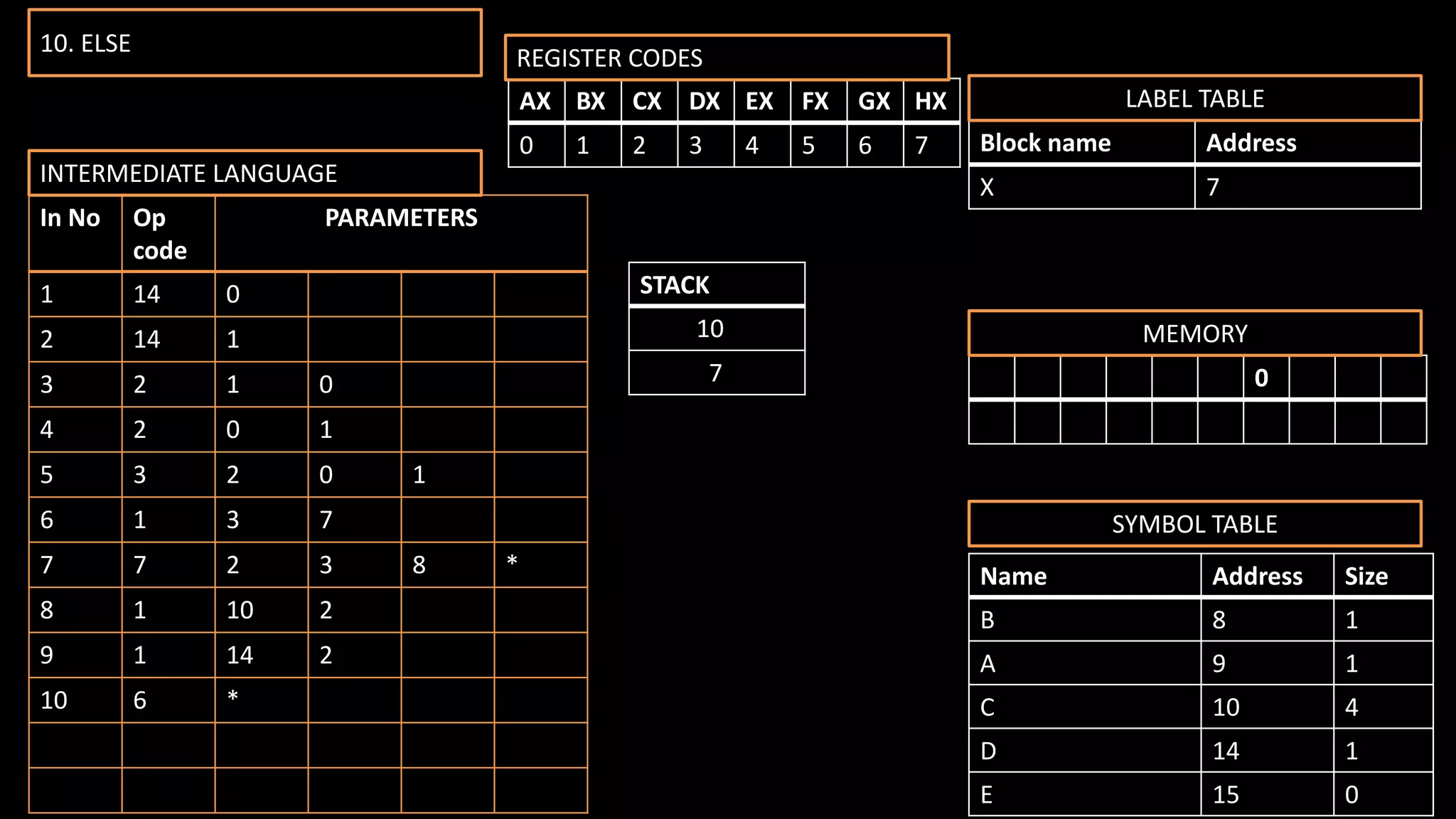
![DATA B
DATA A
DATA C[4]
DATA D
CONST E = 0
START:
READ AX
READ BX
MOV A, AX
MOV B, BX
ADD CX, AX, BX
MOV DX, E
X:
IF CX EQ DX THEN
MOV C[0], CX
MOV D, CX
ELSE
MOV C[1], CX
JUMP X
END
ENDIF](https://image.slidesharecdn.com/compiler-170728124232/75/Assembly-Language-Compiler-Implementation-30-2048.jpg)
![0
MEMORY
Name Address Size
B 8 1
A 9 1
C 10 4
D 14 1
E 15 0
SYMBOL TABLE
In No Op
code
PARAMETERS
1 14 0
2 14 1
3 2 1 0
4 2 0 1
5 3 2 0 1
6 1 3 7
7 7 2 3 8 *
8 2 10 2
9 2 14 2
10 6 *
11 2 11 2
Block name Address
X 7
LABEL TABLE
INTERMEDIATE LANGUAGE
AX BX CX DX EX FX GX HX
0 1 2 3 4 5 6 7
REGISTER CODES
STACK
10
7
11. MOV C[1], CX](https://image.slidesharecdn.com/compiler-170728124232/75/Assembly-Language-Compiler-Implementation-31-2048.jpg)
![0
MEMORY
Name Address Size
B 8 1
A 9 1
C 10 4
D 14 1
E 15 0
SYMBOL TABLE
In No Op
code
PARAMETERS
1 14 0
2 14 1
3 2 1 0
4 2 0 1
5 3 2 0 1
6 1 3 7
7 7 2 3 8 *
8 2 10 2
9 2 14 2
10 6 12
11 2 11 2
Block name Address
X 7
LABEL TABLE
INTERMEDIATE LANGUAGE
AX BX CX DX EX FX GX HX
0 1 2 3 4 5 6 7
REGISTER CODES
STACK
7
11. MOV C[1], CX
When we encounter
“ENDIF” we pop the
stack and store that
value in a temporary
variable. We move to
that Instruction in
Intermediate
Language and
replace the * with
current Instruction
Number](https://image.slidesharecdn.com/compiler-170728124232/75/Assembly-Language-Compiler-Implementation-32-2048.jpg)
![0
MEMORY
Name Address Size
B 8 1
A 9 1
C 10 4
D 14 1
E 15 0
SYMBOL TABLE
In No Op
code
PARAMETERS
1 14 0
2 14 1
3 2 1 0
4 2 0 1
5 3 2 0 1
6 1 3 7
7 7 2 3 8 11
8 2 10 2
9 2 14 2
10 6 12
11 2 11 2
Block name Address
X 7
LABEL TABLE
INTERMEDIATE LANGUAGE
AX BX CX DX EX FX GX HX
0 1 2 3 4 5 6 7
REGISTER CODES
STACK
11. MOV C[1], CX
We pop the stack
again and we move
to that Instruction in
Intermediate
Language and
replace the * with
previously popped
value (i.e. which is
stored in the
temporary variable)
+ 1](https://image.slidesharecdn.com/compiler-170728124232/75/Assembly-Language-Compiler-Implementation-33-2048.jpg)
![DATA B
DATA A
DATA C[4]
DATA D
CONST E = 0
START:
READ AX
READ BX
MOV A, AX
MOV B, BX
ADD CX, AX, BX
MOV DX, E
X:
IF CX EQ DX THEN
MOV C[0], CX
MOV D, CX
ELSE
MOV C[1], CX
ENDIF
END
JUMP X](https://image.slidesharecdn.com/compiler-170728124232/75/Assembly-Language-Compiler-Implementation-34-2048.jpg)
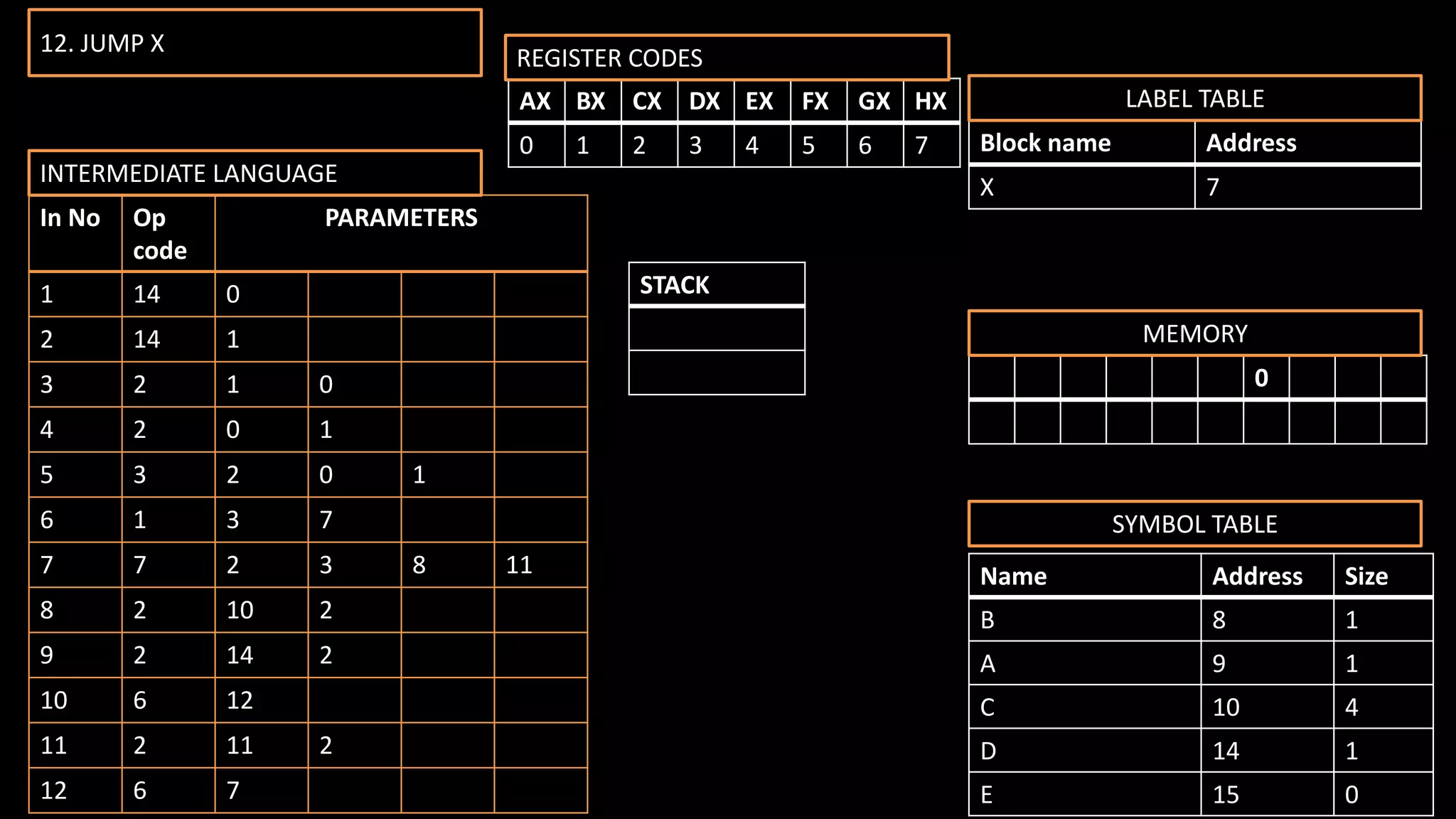
![DATA B
DATA A
DATA C[4]
DATA D
CONST E = 0
START:
READ AX
READ BX
MOV A, AX
MOV B, BX
ADD CX, AX, BX
MOV DX, E
X:
IF CX EQ DX THEN
MOV C[0], CX
MOV D, CX
ELSE
MOV C[1], CX
ENDIF
JUMP X
END](https://image.slidesharecdn.com/compiler-170728124232/75/Assembly-Language-Compiler-Implementation-36-2048.jpg)
